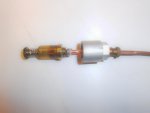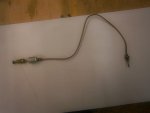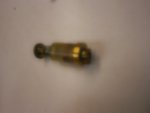ChrisInNotts
Free Member
- Posts
- 596
- Likes
- 642
Hi,
I wonder if anyone could help as I've Googled but not found anyone else with a similar problem? Our fridge (Thetford N100E: manual select but with electronic ignition) cools pretty well on 12V/240V and gas and has been OK up until our last trip. Now, after a number of hours on gas the flame goes out (or at least the gas indicator drops into the red) and it just sits there clicking away to itself failing to re-light. It lights straightaway when you first turn it on (ie pressing and briefly holding the thermostat knob) so no obvious problems with the thermocouple/gas valve. It will also relight manually again by holding the thermostat button in and appears to be OK but then goes out again a number of hours later. The fridge is now sat on my bench and the burner and jet were both clear of any obvious carbon build-up so it appears there is no obvious reason for my problems. There is no pilot jet.
Thus, I assuming the problem seems to be happening when the fridge throttles back the gas when its down to its desired temperature. These are pretty simple fridges but I cannot tell from the information I have if the thermostat shuts the flame off completely or throttles it back to a low level. If the latter, then perhaps the thermocouple has partly failed so is unable to detect the reduced sized flame? This would also make sense if the automatic re-light is performed at a low flame level but the manual start uses full gas pressure. If the former then I am really baffled as I don't see why it lights manually but not automatically? From what I can see the part number for the (very expensive) gas control/thermostat valve is the same as in the manual ignition fridge so that suggests to me that the thermostat regulates cooling by flame size rather than cycling the burner on a fixed flame size. Can anyone confirm if this is the case?
I cannot see the flame in situ and its not quick and simple getting the fridge in/out so I really want to do as much as I can to trouble shoot this before I put it back. Thus, I would be grateful for any advice/tips.
Thanks,
Keith
I wonder if anyone could help as I've Googled but not found anyone else with a similar problem? Our fridge (Thetford N100E: manual select but with electronic ignition) cools pretty well on 12V/240V and gas and has been OK up until our last trip. Now, after a number of hours on gas the flame goes out (or at least the gas indicator drops into the red) and it just sits there clicking away to itself failing to re-light. It lights straightaway when you first turn it on (ie pressing and briefly holding the thermostat knob) so no obvious problems with the thermocouple/gas valve. It will also relight manually again by holding the thermostat button in and appears to be OK but then goes out again a number of hours later. The fridge is now sat on my bench and the burner and jet were both clear of any obvious carbon build-up so it appears there is no obvious reason for my problems. There is no pilot jet.
Thus, I assuming the problem seems to be happening when the fridge throttles back the gas when its down to its desired temperature. These are pretty simple fridges but I cannot tell from the information I have if the thermostat shuts the flame off completely or throttles it back to a low level. If the latter, then perhaps the thermocouple has partly failed so is unable to detect the reduced sized flame? This would also make sense if the automatic re-light is performed at a low flame level but the manual start uses full gas pressure. If the former then I am really baffled as I don't see why it lights manually but not automatically? From what I can see the part number for the (very expensive) gas control/thermostat valve is the same as in the manual ignition fridge so that suggests to me that the thermostat regulates cooling by flame size rather than cycling the burner on a fixed flame size. Can anyone confirm if this is the case?
I cannot see the flame in situ and its not quick and simple getting the fridge in/out so I really want to do as much as I can to trouble shoot this before I put it back. Thus, I would be grateful for any advice/tips.
Thanks,
Keith



